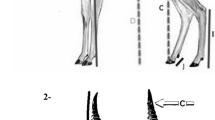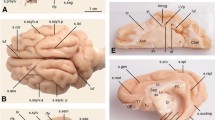Summary
An intraspecific allometric comparison between the brain weights of feral pigs from the Galapagos Islands and those of European domestic pigs shows identical brain sizes in relation to the body sizes. The return of domestic pigs to the wild life state some generations ago has produced no increase in brain size. Hence this process is not reversible to the process of domestication, domestic pigs having 33% smaller brains than free living mutuals of their ancestral species the European wild boar (Sus scrofa scrofa L.).
However, quantitative investigation shows a partly different composition of the brains of feral pigs compared with those of European domestic pigs. Of the fundamental brain parts, telencephalon and mesencephalon of the feral pigs are not different in volume size, whereas diencephalon and medulla oblongata are 6.5% and 10% larger, respectively; the cerebellum on the contrary is about 11% smaller than in domestic pigs. A further subdivision of the telencephalon into the regions of neocortex, corpus striatum and allocortex, and that of the allocortex into some olfactory and limbic centers, elucidates other differences. A discussion of these results under functional aspects and in connection with the process of return to wild-life conditions is given.
Similar content being viewed by others
References
Ebinger, P.: Cytoarchitektonischer Volumenvergleich an Gehirnen von Wild- und Hausschafen. Diss. TU Hannover (1973)
Hassler, R.: Zur funktionellen Anatomie des limbischen Systems. Nervenarzt 35, 386–396 (1964)
Herre, W., Röhrs, M.: Domestikation und Stammesgeschichte. In: Die Evolution der Organismen, Bd. II/2, S. 29–174 (G. Heberer, ed.). Stuttgart: Fischer 1971a
Herre, W., Röhrs, M.: Über die Verwilderung von Haustieren. Milu (Leipzig) 3, 131–160 (1971b)
Herre, W., Röhrs, M.: Haustiere — zoologisch gesehen. Stuttgart: Fischer 1973
Kruska, D.: Vergleichend cytoarchitektonische Untersuchungen an Gehirnen von Wild- und Hausschweinen. A. Anat. Entwickl.-Gesch. 131, 291–324 (1970)
Kruska, D.: Volumenvergleich optischer Hirnzentren bei Wild- und Hausschweinen. Z. Anat. Entwickl.-Gesch. 138, 265–282 (1972)
Kruska, D.: Cerebralisation, Hirnevolution und domestikationsbedingte Hirnänderungen innerhalb der Ordnung Perissodactyla Owen, 1848 und ein Vergleich mit der Ordnung Artiodactyla Owen, 1848. Z. zool. Syst. Evol.forsch. 11, 81–103 (1973a)
Kruska, D.: Domestikationsbedingte Größenänderungen verschiedener Hirnstrukturen bei Schwienen. In: Domestikationsforschung und Geschichte der Haustiere. Internat. Symposion in Budapest 1971, 135–140 (J. Matolsci, ed.). Budapest: Akademiai Kiado 1973b
Kruska, D., Stephan, H.: Volumenvergleich allokortikaler Hirnzentren bei Wild- und Hausschweinen. Acta anat. (Basel) 84, 387–415 (1973)
Letts, G. A.: Feral animals in the Northern Territory. Aust. vet. J. 40, 84–88 (1964)
Pullar, E. M.: The wild (feral) pigs of Australia and their role in the spread of infectious diseases. Aust. vet. J. 26, 99–110 (1950)
Röhrs, M.: Allometrieforschung und biologische Formanalyse. Z. Morph. Anthrop. 51, 289–321 (1961)
Röhrs, M., Kruska, D.: Der Einfluß der Domestikation auf das Zentralnervensystem und Verhalten von Schweinen. Dtsch. tierärztl. Wschr. 75, 514–518 (1969)
Schleifenbaum, C.: Untersuchungen zur postnatalen Ontogenese des Gehirns von Großpudeln und Wölfen. Z. Anat. Entwickl.-Gesch. 141, 179–205 (1973)
Schultz, W.: Zur Kenntnis des Hallstromhundes (Canis hallstromi, Troughton 1957). Zool. Anz. 183, 47–72 (1969)
Shank, C. C.: Some aspects of social behaviour in a population of feral goats (Capra hircus L.). Z. Tierpsychol. 30, 488–528 (1972)
Stephan, H.: Methodische Studien über den quantitativen Vergleich architektonischer Struktureinheiten des Gehirns. Z. wiss. Zool. 164, 143–172 (1960)
Stephan, H.: Die kortikalen Anteile des limbischen Systems (Morphologie und Entwicklung). Nervenarzt 35, 396–401 (1964)
Stephan, H.: Größenveränderungen im olfaktorischen und limbischen System während der phylogenetischen Entwicklung der Primaten. In: Evolution of the Forebram, S. 377–388 (R. Hassler and H. Stephan, eds.). Stuttgart: Thieme 1966
Stephan, H., Bauchot, R., Andy, O. J.: Data on size of the brain and of various brain parts in insectivores and primates. In: Advances in primatology, vol. 1, p. 289–297 (Ch. R. Noback and W. Montagna eds.). New York: Appleton Century Crofts 1970
Author information
Authors and Affiliations
Additional information
Dedicated in gratitude to our honoured teacher and friend Prof. Dr. sci. nat. Dr. med. h. c. Wolf Herre on his 65th birthday.
The term feral is a synonym for the German word “verwildert”. It means non-indigenous, free-living or wild animals originating from domestic stock. This definition was already used by Pullar (1950), Letts (1964), Shank (1972) and others.
Rights and permissions
About this article
Cite this article
Kruska, D., Röhrs, M. Comparative-quantitative investigations on brains of feral pigs from the Galapagos Islands and of European domestic pigs. Z. Anat. Entwickl. Gesch. 144, 61–73 (1974). https://doi.org/10.1007/BF00518633
Received:
Issue Date:
DOI: https://doi.org/10.1007/BF00518633




